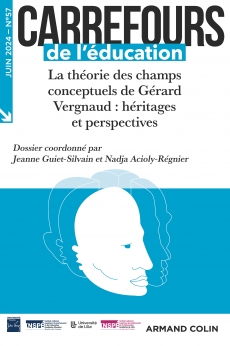
CARREFOURS DE L'ÉDUCATION N°57 (1/2024)
Pour acheter ce numéro, contactez-nous
Recevez les numéros de l'année en cours et accédez à l'intégralité des articles en ligne.
Le numérique s’accentue à l’école au rythme des innovations. Comprendre la mise en place de pratiques enseignantes nouvelles est un enjeu fort pour la recherche et la formation. Ce texte illustre ce que l’oeuvre de Gérard Vergnaud peut apporter à ce thème. Il revisite pour cela une étude qui analysait les pratiques d’enseignants intégrant pour la première fois programmation et robotique en mobilisant deux cadres de la didactique des mathématiques. En combinant le concept de schème aux construits théoriques issus de ces cadres, l’étude montrait que l’enseignant gère les séances nouvelles en réduisant la distance aux schèmes anciens que ces séances généraient, et en élaborant des repères didactiques, sources de futurs schèmes. L’article illustre alors les filiations et complémentarités entre les travaux de Gérard Vergnaud et ces deux cadres, et l’utilité de continuer à les faire dialoguer pour analyser l’activité enseignante en situation nouvelle.
The digital environment is gaining in strength in schools as innovations develop. Unders-tanding the development of new teaching practices is a major issue for research and for professional training. This paper shows what Gérard Vergnaud can bring to this theme. For this purpose, the paper re-examines a study that analysed the practice of teachers integrating for the first time robotics and software programming by mobilising two framewworks originating in the didacticism of mathematics. By combining the concept of schema, with the theoretical constructs issuing from these frameworks, the study showed that the teacher was handling new sessions by reducing the distance from old schemas that these sessions were producing, and by generating didactic points of reference, the source of future schemas. This present paper then highlights the relationships and complementarities between Gérard Vergnaud’s work and these two frameworks, and the usefulness of continuing to confront them in order to analyse a teaching activity within a new environment.